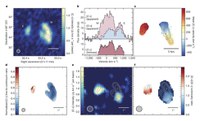A Massive Galaxy in the Early Universe
According to our current understanding of cosmic structure formation, the precursors of the most massive structures in the Universe began to form shortly after the Big Bang, in regions corresponding to the largest fluctuations in the cosmic density field. Observing these structures during their period of active growth and assembly—the first few hundred million years of the Universe—is challenging because it requires surveys that are sensitive enough to detect the distant galaxies that act as signposts for these structures and wide enough to capture the rarest objects. As a result, very few such objects have been detected to date.
In this contribution, Marrone et al. report observations of a far-infrared-luminous object at redshift 6.900– just 780 million years after the Big Bang–that was discovered in a wide-field survey. This object, SPT0311−58, was originally identified in the 2,500-deg2 South Pole Telescope survey as a luminous source with a steeply increasing spectrum, indicative of thermal dust emission. Observations with ALMA provide the redshift of the source.
High-resolution imaging shows it to be a pair of extremely massive star-forming galaxies. The larger is forming stars at a rate of 2,900 M⊙ per year, contains 270 billion M⊙ of gas and 2.5 billion M⊙ of dust, and is more massive than any other known object at a redshift of more than 6. Its rapid star formation is probably triggered by its companion galaxy at a projected separation of 8 kiloparsecs. This merging companion hosts 35 billion M⊙ of stars and has a star-formation rate of 540 M⊙ per year, but has an order of magnitude less gas and dust than its neighbor and physical conditions akin to those observed in lower-metallicity galaxies in the nearby Universe. These objects suggest the presence of a dark-matter halo with a mass of more than 100 billion M⊙, making it among the rarest dark-matter haloes that should exist in the Universe at this epoch.
Image: Image & spectra of the [CII] and [OIII] emission from the z=6.9 lensed starburst galaxy SPT0311-58.
Publication: D.P. Marrone (Steward Observatory, University of Arizona) et al., Galaxy Growth in a Massive Halo in the First Billion Years of Cosmic History, 4 January 2018, Nature, 553, 51.





Connect with NRAO